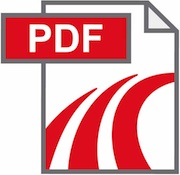In late August, global headlines spotlighted a bizarrely epic traffic jam in China. Stretching over one hundred kilometers, the jam left thousands of Chinese drivers stranded on a major expressway for over a week.
Too much traffic slows everything down. In the U.S. legal system, bottlenecks occur in a somewhat different way–most notoriously, in paper chases and information overload. On average, more than 400 new cases are added to a federal district court judge's docket every year, according to the U.S. Courts website. Some courts limit the time judges have to rule on motions, and with overloaded dockets, judges have even less time to review the supporting materials for these motions. It is therefore imperative for an attorney to be able to present a brief to the court in a streamlined and effective way. A party who wants to win must be sure the court can smoothly access critical information in order to quickly grasp and appreciate the argument.
To help manage dockets, federal courts and several state courts have implemented the electronic case filing (ECF) system. ECF has made drastic strides toward streamlining the filing process; however, the system is not without its shortcomings. For example, attorneys are required to provide all of their materials to the court in individual PDFs, and file size limitations often make it necessary to separate a single document into multiple files. In the end, the court must still maneuver through numerous files to review a brief and its supporting materials.
Submitting one consolidated package in an interactive format is the solution. In fact, the utility of a hyperlinked brief picks up precisely where ECF limitations begin. Mirroring the familiar and intuitive logic of clicking through linked Web pages, hyperlinked briefs are a simple and even obvious remedy to streamline the court's normally cumbersome review process. Presenting a hyperlinked brief to the court helps to gain favor with judges, and the brief is sure to stand out among the unwieldy mass of other pending matters.
What is a Hyperlinked Brief?
As the name suggests, this tool attaches hyperlinks to all citations in a brief, providing instant access to a precise reference within a cited document. For example, a hyperlink will deliver the reader to the exact page of an exhibit, pincite within a case or subsection of a statute, where the reader may check the referenced material for accuracy or scroll through the cited document for related information.
 After reviewing the supporting document, the reader clicks a button to return to the exact section of the brief and resume reading. Hyperlinks can also attach to video, audio, graphics and custom demonstratives, which often enable the attorney to present evidence more effectively.
After reviewing the supporting document, the reader clicks a button to return to the exact section of the brief and resume reading. Hyperlinks can also attach to video, audio, graphics and custom demonstratives, which often enable the attorney to present evidence more effectively.
Notably, hyperlinked briefs offer full access to all cited legal authorities, which are not commonly included in ECF submissions. The ready availability of all relevant materials is a tremendous convenience for the court because it eliminates several otherwise necessary research steps and enables the court to glide smoothly through the argument without changing course. This additionally results in a subtle but strong advantage to the submitting party by ensuring the court will thoroughly review the support for the argument.
Hyperlinked briefs have been used for over a decade, and they encourage courts to perform an exhaustive review of all supporting documents. Judges, law clerks and arbitrators are receptive to "courtesy" briefs, and some courts even issue invitations and requests to submit corresponding briefs. An interactive format is easier to navigate in a shorter amount of time.
In one case study, hyperlinked briefs were used for filings in a large securities class action in federal court. The case involved numerous banks and creditors. An expert service provider worked with more than ten law firms to create hyperlinked briefs for over 2,500 pages. Although many of the relationships between the parties were adversarial and contentious, all parties agreed that it was best to present the court with one cohesive interactive format. This was a way to ease the court's review and to keep the case on schedule moving toward trial. The judge was so appreciative of the interactive briefs that he has gone on to recommend their use in other matters.
When to Use a Hyperlinked Brief
Hyperlinked briefs can be used to enhance any filing throughout the entire litigation process. They are most commonly used for summary judgment briefs, but they are beneficial as early as motions to dismiss, as well as at the final stage for post-trial findings of fact and conclusions of law. Fact sensitive matters are naturally suited for hyperlinked briefs because the force of a party's exhibits and testimony are pivotal. It is necessary for the judge to read the exact sections of those documents without wasting time thumbing through pages of documents. At the appellate level, hyperlinked briefs can be critical in linking the judge – literally – to the crux of the argument.
Hyperlinked briefs are valuable in other contexts as well. They are frequently used in alternative dispute resolution, especially with arbitration briefs, mediation reports and settlement reports. In fact, a presentation can be enhanced with hyperlinks in ways limited only by an attorney's creativity. Aside from a traditional briefing, this tool can be used to review client or internal memoranda, coverage opinions and expert reports. It also functions to create a catalog of exhibits and trial documents for exchange or to create an exhibit or graphic archive of materials after a case is closed.
How to Submit a Hyperlinked Brief
 Many attorneys choose to create hyperlinked briefs on their own using Adobe Acrobat. This can be a viable option in small cases with very few documents, citations and supporting materials. However, attorneys must invest significant time and energy in learning and applying the latest version of this software. As case sizes begin to grow and the number of exhibits and references increase, identifying, locating, creating and testing all of the links can be an overwhelming process to manage. Enlisting the expertise of a trial services provider assures quality control and swift turnaround. Providers can also embed video files with captioning and create custom graphics or animation.
Many attorneys choose to create hyperlinked briefs on their own using Adobe Acrobat. This can be a viable option in small cases with very few documents, citations and supporting materials. However, attorneys must invest significant time and energy in learning and applying the latest version of this software. As case sizes begin to grow and the number of exhibits and references increase, identifying, locating, creating and testing all of the links can be an overwhelming process to manage. Enlisting the expertise of a trial services provider assures quality control and swift turnaround. Providers can also embed video files with captioning and create custom graphics or animation.
A provider with dedicated resources can simplify the creation of a hyperlinked brief. After filing, an attorney submits electronic files of the brief and supporting materials to a trial services expert. The expert manually creates the links and thoroughly reviews them for accuracy. Many trial services providers offer additional features, such as a detailed bookmarking panel to efficiently categorize content for quick and easy access to every section of the filing, custom highlighting to draw attention to critical passages within supporting materials and web tools allowing the judge or clerk to annotate. After the completion of a project, one attorney commented, "The team obviously made extraordinary efforts to complete the linking for our 230-page brief overnight. Despite the heavy workload, [the expert] was always available to respond to our request and promptly correct any errors. Her professionalism and the dedication of her team were evident from the beginning to the end of the process." In contrast, without ensuring the requisite expertise and resources, a project could easily fall flat.
 Upon completion, the attorney has an opportunity to review the proofs before the brief is finalized. The finished brief is then assembled on a CD in PDF format and is also made accessible through a secured website. No case is too voluminous, as the media deliverable can be customized to contain unlimited amounts of data. Most hyperlinked briefs are completed and ready to submit to the court within a few days of filing. Trial services providers can advise on court preferences for submitting to specific venues. Increasingly, courts are encouraging the submission of hyperlinked briefs by including guidelines in their rules.
Upon completion, the attorney has an opportunity to review the proofs before the brief is finalized. The finished brief is then assembled on a CD in PDF format and is also made accessible through a secured website. No case is too voluminous, as the media deliverable can be customized to contain unlimited amounts of data. Most hyperlinked briefs are completed and ready to submit to the court within a few days of filing. Trial services providers can advise on court preferences for submitting to specific venues. Increasingly, courts are encouraging the submission of hyperlinked briefs by including guidelines in their rules.
Conclusion
Judges have repeatedly praised hyperlinked briefs for their convenience and functionality. A California judge stated he "wishes more attorneys would file this way," and he especially "liked that he could take it home." A Wisconsin judge remarked, "I love [hyperlinked briefs]," and the best aspect "is its portability. . . . I took the CD home with me and did not have to drag any boxes with me. . . . I also liked the hyperlink feature . . . it allowed me to check the accuracy of the information cited in the brief . . . I was really impressed with it and showed it to several judges in the courthouse." A Texas arbitrator concurs, "the [hyperlinked brief] makes review of the brief easier, and the easier you make something, the more likely people are to see what you want them to see and to do what you want them to do."
A hyperlinked brief enables the court to perform a critical review of the documents the attorney deems most determinative in the client's case. This intelligent tool is an easy to obtain must-have for presenting a seamless argument to the court, as well as an obvious solution to the longstanding problem of backlogged dockets.
To view a sample of a hyperlinked brief, please visit:http://www.krollontrack.com/iBrief-demo/
Christine Falcicchio, Esq., is a senior iBrief consultant at Kroll Ontrack/TrialGraphix. She holds a J.D. from Seton Hall University is licensed to practice in Florida. Christine is an expert in the development of interactive court filings for trial attorneys, law firms and corporate counsel. She can be reached for questions or comments at Christine.falcicchio@trialgraphix.com.
Dan Wolfe, J.D., Ph.D., is a director of jury consulting at Kroll Ontrack/TrialGraphix. He provides research-based and experiential data analysis to trial teams nationwide and oversees the standards in practice of the jury consulting department. Dan is an expert in the fields of witness preparation, voir dire and jury selection, and is also skilled in providing quantitative and qualitative analyses of venue through focus groups and mock trials. He can be reached for questions or comments at dwolfe@trialgraphix.com.